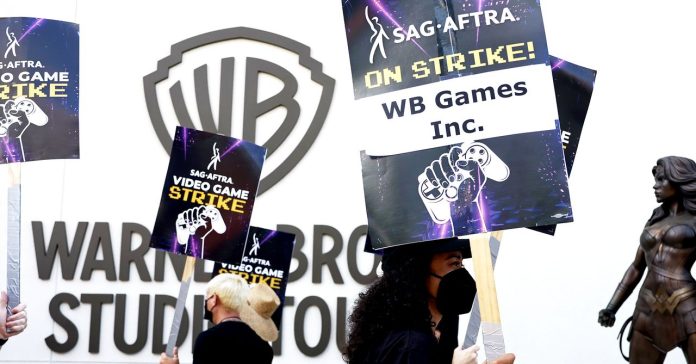On Wednesday, members of the Screen Actors Guild–American Federation of Television and Radio Artists, or SAG-AFTRA, voted to ratify a new contract for video game performers, officially bringing an end to a nearly yearlong strike. A majority, 95 percent of members, voted in favor of the contract, which guarantees annual raises for three years, increased compensation, and guardrails designed to prevent game companies from giving their work to AI.
Actors in the video game industry had been on strike for 11 months as part of a fight to secure protections against AI, a sticking point that held up negotiations for most of that time. Every other issue in the contract, including compensation and working conditions, was already resolved months ago, says SAG-AFTRA’s national executive director and chief negotiator Duncan Crabtree-Ireland. The strike was temporarily suspended in June, pending contract ratification.
According to Sarah Elmaleh, a voice actor who also serves as a SAG-AFTRA committee chair, actors in the games industry have been wearily eyeing AI for years—even before tools like ChatGPT exploded in use. “We knew that this was the issue of most existential importance,” Elmaleh says. “This is a medium that is fundamentally digitized.”
Performers’ work is crucial to game creation. Actors voice characters, help make those characters look more natural by doing motion capture, and even allow companies to use their likenesses. And though AI is impacting industries across the board, including animation, tech, education, and others, the video game industry has begun to feel those effects acutely.
As part of the contract, consent and disclosure agreements are now required when any video game maker wants to use a performer’s voice or likeness to make an AI-driven digital replica. Should performers go on strike, they are also allowed to suspend their approval for companies to generate any new material with AI.
AI is already starting to replace flesh-and-blood actors, even in high-profile cases. In May, Fortnite introduced a generative AI version of Star Wars’ Darth Vader. (Players disastrously had him saying swears and slurs in only a few hours. Fortnite maker Epic Games pushed a hotfix soon thereafter.) A few days later, SAG-AFTRA filed an unfair labor practice charge with the National Labor Relations Board against Epic subsidiary Llama Productions. In a statement posted to SAG-AFTRA’s website, the organization said replacing a human worker with AI was done “without providing any notice of their intent to do this and without bargaining with us over appropriate terms.”
Darth Vader actor James Earl Jones gave permission to have his voice digitally recreated with AI before his death in 2024. Crabtree-Ireland would not comment on specific performers or contracts. However, he says that protections need to be applied consistently and with a “reasonably specific” description of how their image or voice will be used. “These provisions ensure that a deceased artist’s image, voice, and performance are treated with the same respect as a living artist’s,” Crabtree-Ireland says.
The companies that make video games, says Crabtree-Ireland, are on the cutting edge of AI technology. “It was really important for us to draw this line,” he says, “because we knew that the boundaries were going to be tested in the video game space earlier and more vigorously than they are in almost any other.” Companies SAG-AFTRA has been bargaining with include Activision, Electronic Arts, Insomniac Games, Take 2 Productions, WB Games, and more.
According to Audrey Cooling, a spokesperson for the bargaining group representing the companies involved, video game producers are pleased SAG-AFTRA members ratified the agreement. “We look forward to building on our industry’s decades-long partnership with the union and continuing to create groundbreaking entertainment experiences for billions of players worldwide,” says Cooling.
Game companies owe actors “basic working conditions and decency,” says Elmaleh, pointing to the value actors add to games. “Otherwise they wouldn’t be here negotiating with us.”
Elmaleh calls voice acting and motion capture “a secret weapon” in a field where everything is digital. “It imbues persuasiveness and immersion, reality and weight to the rest of the environment,” says Elmaleh, whose credits include blockbuster titles such as Fortnite, The Last of Us Part II, and Halo Infinite. “It feels a bit foolhardy to kind of throw away that kind of superpower in your tool kit to immediately connect with players.”
The fight in video games is a big one that may yet set the tone for other entertainment sectors. “It’s a huge industry that has a lot of impact,” Crabtree-Ireland says. “It’s an industry that has a very devoted fan base that crosses over with consumers and the other industries that our members work in … What we do in one contract impacts other contracts.”
Working in lockstep with actors in the game sector will ultimately help future negotiations in other creative fields. Crabtree-Ireland says he believes that they’ve yet to see the full boundaries on how AI will be used. “Whatever is going to be done with AI technology,” he says, “whether that’s replicating human voices, human images, whether it’s creating new synthetic performers—it needs to be done in an environment of respect to the performers that are involved.”
